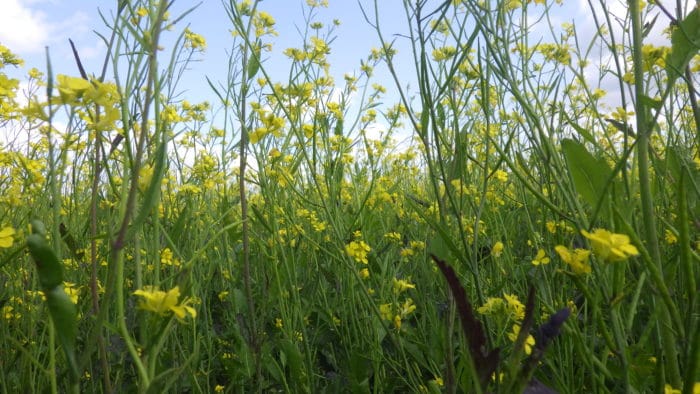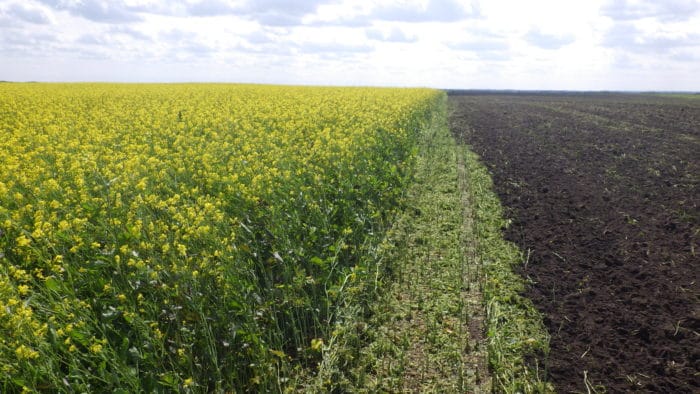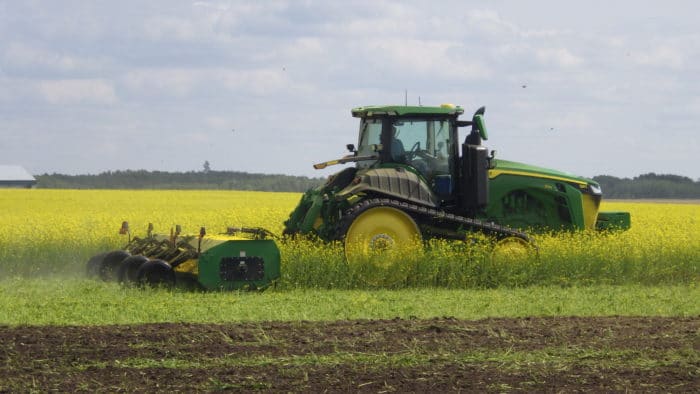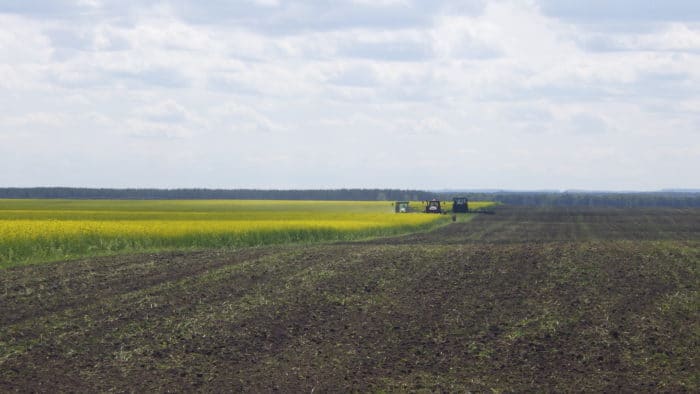A team of researchers in Manitoba have found success using mustard biofumigation to rid fields of Verticillium wilt.
Experts


Editor’s note: This interview has been edited for length and clarity.
Spud Smart (SS): What is biofumigation?
Haider Abbas (HA): Biofumigation is the suppression of soilborne pests and diseases through the use of plants that produce inhibitory chemicals. In most cases, these biochemical plants are chopped and incorporated into the soil so they can release their inhibitory chemical. Mustard is a well understood biofumigant.
Mustard and most other plants from the brassica family produce chemicals called glucosinolates. When glucosinolates come in contact with water and enzymes contained in plant cells, they are transformed into another group of compounds called isothiocyanate. And it is these isothiocyanates that gives mustard its biofumigation power. Theoretically, with the increase in biomass production glucosinolate levels, levels are also increased in a biofumigant crop.

Speaking about the control of soilborne pests through the biofumigation process, mustard has been shown to control a variety of soilborne pests. These include verticillium rhizoctonia, fusarium, pythium, sclerotinia, common scab and range of nematodes. The use of mustard as a bioumigant has also shown a decrease in damage caused by wireworms.
SS: How does mustard work as a biofumigant?
When using mustard or any other crop as a biofumigant, it is important to know the targeted pest and its lifecycle. The biofumigant crops should be incorporated when the pest is present in the upper soil profile, that will be about 15 to 20 centimeters. Seeding dates should be planned accordingly in order for the crop to have the maximum biomass at the time of incorporation.
Seeding rates should be based on the pest you are targeting — a mustard should be seeded about 60 days before the pest will be present in the field. So, you should really know your field as much mustard should be incorporated into the soil before seed production begins in mustard.
Seeding rates should be planned accordingly in order for the crop to have reached maximum biomass at the time of incorporation. And depending on the variety and growing conditions, it takes about 60 to 70 days to attain maximum biomass production there. Mustard cultivars are also very important in this regard.
SS: What mustard types have been used for biofumigation in Manitoba?
HA: Mustard comes in many varieties but not all varieties are equally as effective when it comes to biofumigation process. Some mustard variety produce more glucosinolate levels compared to others. In fact, some varieties have been bred for the sole purpose of biofumigation.

For example, Caliente Rojo is a variety that is bred for biofumigation purpose. Caliente Rojo grows quickly and is typically used in spring or late summer and bred specifically for biofumigation as it contains very high levels of glucosinolates.
At the MCDC, the Manitoba Crop Diversification Centre, we have tested four mustard varieties including Caliente Rojo, AC Vulcan, Andante, AAC Brown 18.
SS: What are the best practices for using biofumigation as a disease prevenient?
HA: For the best results, pH of the soil should be above 5.5. If the field has a pH lower than 5.5, the biofumigation process might not be successful. For optimum results, the pH of soil should be as close as possible.
Furthering to the key to successful biofumigation, fertilizer is also very important to the production of biomass and sulfur is crucial for the production of glucosinolates. Nitrogen is applied depending on the fields nutrient history, and the rate of sulfur should be adjusted in relation to the chosen nitrogen rate, in a six to one ratio.
Managing all these factors successfully help in increasing the biomass production that also increased glucosinolate levels in the mustard crop. It won’t be wrong to say that biomass and glucosinolates are factors that are fundamental to the success of biofumigation.
Irrigation is also another factor for best results, mustard needs eight to nine inches of water —about half of it four to five inches is needed during the first month to keep the bed moist.
SS: How does incorporation work?
HA: The final step in this process is soil incorporation. A few considerations should be taken into account when incorporating the mustard crop into the soil. And mustard crops should be incorporated into the soil before it has reached to the full bloom.
Incorporation process should be done when the soil has a good level of moisture and do not incorporate mustard when the soil is dry. That’s also a key to successful biocommunication purpose.

Mustard must be incorporated immediately after mowing, 80 per cent of the fumigant gas will be released in the first 20 minutes after mowing and after incorporation pH should be rolled and packed to trap the fumigant gas in the soil.
Finally, once the incorporation process is completed, leave the field undisturbed for at least 14 days to ensure that all plant material can be broken down.
SS: Why are biofumigants specific to region?
ZF: Not all of these mustards have the equivalent biofumigation potential when it comes to Verticillium wilt or managing any of these other specific pests or pathogens that are trying to be targeted. And even in these cases where you’re trying to target Verticillium wilt, then you have the Caliente Rojo cultivars for example, you got the correct mustard but if you apply the incorrect method, this will lead you to an unsuccessful biofumigation.
In the conversations that I had about mustard biofumigation in Manitoba in ’17 and ’18, when growers were experimenting on their own, the initial results were frustrating and they didn’t think it was working. The problem turned out to be the situation with the correct mustard and the incorrect method, which prevented the process from getting over the finish line. So, it’s important that you pair it the two and this is where it becomes critical to make sure that the mustard and the method really have been experimentally verified in your region.
There are a fair number of people that have tried mustard biofumigation in other provinces with varying results. It’s important to take their considerations in account for some of these local adaptations. We started out with a protocol from the United States for biofumigation with Caliente Rojo. This protocol in itself was originally developed in Italy and adapted to the United States, so it makes sense that we had to make further alterations to succeed in Manitoba. I would expect other regions to have to make similar adaptions.
SS: Why is irrigation needed?
ZF: We really need to irrigate the Caliente to get the big biomass so far, with upwards of eight or nine inches being put down over two months. Four to five inches are generally applied in the first month to keep the seedbed moist. Some growers avoid extra irrigation with early planting, instead of planting in late July, to keep the seed bed moist with less water.

However, in talking with growers throughout Manitoba, it’s uncommon to have dedicated pivots. So, the need to irrigate really has been the Achilles’ heel of the whole process, which is part of what led Haider and I to fragment the project into several different ideas that we are exploring together at the moment.
One fragment explores what we can do with dryland Caliente Rojo — are there other benefits to biofumigation that can be explored? Another fragment clarifies if the Caliente Rojo fields with bigger biomass are able to achieve Verticillium wilt management. The third fragments is where Haider and I are exploring if other mustards are able to achieve Verticillium management with dryland production.










